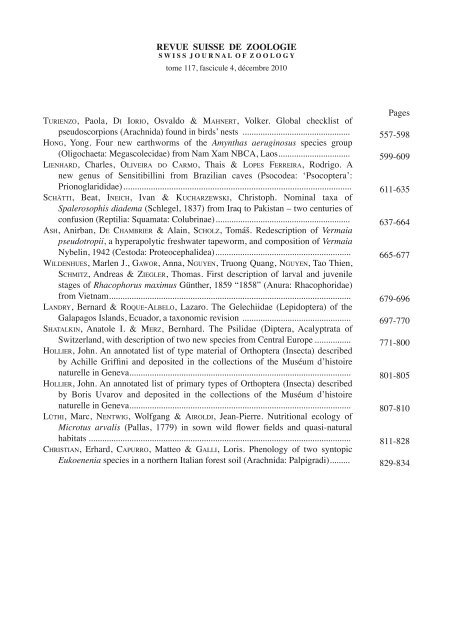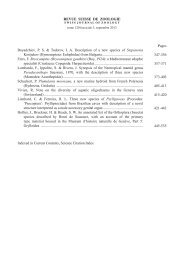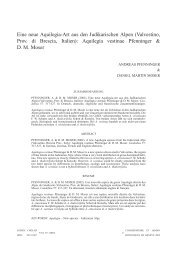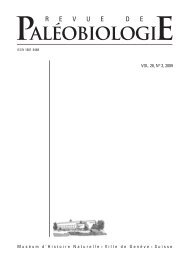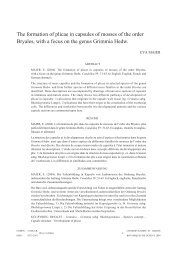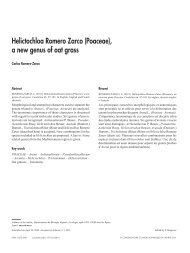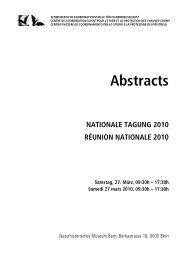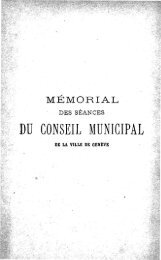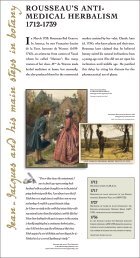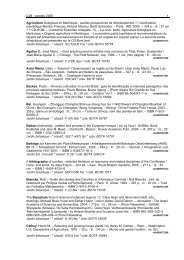Revue suisse de Zoologie TURIENZO, Paola, D I ... - Ville de Genève
Revue suisse de Zoologie TURIENZO, Paola, D I ... - Ville de Genève
Revue suisse de Zoologie TURIENZO, Paola, D I ... - Ville de Genève
You also want an ePaper? Increase the reach of your titles
YUMPU automatically turns print PDFs into web optimized ePapers that Google loves.
<strong>Revue</strong> <strong>suisse</strong> <strong>de</strong> <strong>Zoologie</strong><br />
s W i s s J o u R N A l o F Z o o l o g Y<br />
tome 117, fascicule 4, décembre 2010<br />
Turienzo, <strong>Paola</strong>, Di iorio, Osvaldo & MahnerT, Volker. Global checklist of<br />
pseudoscorpions (Arachnida) found in birds’ nests ................................................<br />
hong, Yong. Four new earthworms of the Amynthas aeruginosus species group<br />
(Oligochaeta: Megascolecidae) from Nam Xam NBCA, Laos ................................<br />
LienharD, Charles, oLiveira Do CarMo, Thais & Lopes Ferreira, Rodrigo. A<br />
new genus of Sensitibillini from Brazilian caves (Psoco<strong>de</strong>a: ‘Psocoptera’:<br />
Prionoglarididae) ....................................................................................................<br />
sChäTTi, Beat, ineiCh, Ivan & KuCharzewsKi, Christoph. Nominal taxa of<br />
Spalerosophis dia<strong>de</strong>ma (Schlegel, 1837) from Iraq to Pakistan – two centuries of<br />
confusion (Reptilia: Squamata: Colubrinae) ............................................................<br />
ash, Anirban, De ChaMbrier & Alain, sChoLz, Tomáš. Re<strong>de</strong>scription of Vermaia<br />
pseudotropii, a hyperapolytic freshwater tapeworm, and composition of Vermaia<br />
Nybelin, 1942 (Cestoda: Proteocephali<strong>de</strong>a) ............................................................<br />
wiLDenhues, Marlen J., gawor, Anna, nguyen, Truong Quang, nguyen, Tao Thien,<br />
sChMiTz, Andreas & ziegLer, Thomas. First <strong>de</strong>scription of larval and juvenile<br />
stages of Rhacophorus maximus Günther, 1859 “1858” (Anura: Rhacophoridae)<br />
from Vietnam ...........................................................................................................<br />
LanDry, Bernard & roque-aLbeLo, Lazaro. The Gelechiidae (Lepidoptera) of the<br />
Galapagos Islands, Ecuador, a taxonomic revision ................................................<br />
shaTaLKin, Anatole I. & Merz, Bernhard. The Psilidae (Diptera, Acalyptrata of<br />
Switzerland, with <strong>de</strong>scription of two new species from Central Europe ................<br />
hoLLier, John. An annotated list of type material of Orthoptera (Insecta) <strong>de</strong>scribed<br />
by Achille Griffini and <strong>de</strong>posited in the collections of the Muséum d’histoire<br />
naturelle in Geneva ..................................................................................................<br />
hoLLier, John. An annotated list of primary types of Orthoptera (Insecta) <strong>de</strong>scribed<br />
by Boris Uvarov and <strong>de</strong>posited in the collections of the Muséum d’histoire<br />
naturelle in Geneva ..................................................................................................<br />
LüThi, Marc, nenTwig, Wolfgang & airoLDi, Jean-Pierre. Nutritional ecology of<br />
Microtus arvalis (Pallas, 1779) in sown wild flower fields and quasi-natural<br />
habitats ....................................................................................................................<br />
ChrisTian, Erhard, Capurro, Matteo & gaLLi, Loris. Phenology of two syntopic<br />
Eukoenenia species in a northern Italian forest soil (Arachnida: Palpigradi) .........<br />
Pages<br />
557-598<br />
599-609<br />
611-635<br />
637-664<br />
665-677<br />
679-696<br />
697-770<br />
771-800<br />
801-805<br />
807-810<br />
811-828<br />
829-834
<strong>Revue</strong> <strong>suisse</strong> <strong>de</strong> <strong>Zoologie</strong><br />
s W i s s J o u R N A l o F Z o o l o g Y<br />
tome 117, fascicule 4, décembre 2010<br />
Résumés<br />
global checklist of pseudoscorpions (Arachnida) found in birds’ nests<br />
<strong>Paola</strong> <strong>TURIENZO</strong> 1 , Osvaldo DI IORIO 1 & Volker MAHNERT 2<br />
1 Entomología. Departamento <strong>de</strong> Biodiversidad y Biología Experimental, Facultad <strong>de</strong> Ciencias<br />
Exactas y Naturales, 4ľ Piso, Pabellón II, Ciudad Universitaria<br />
C1428EHA, Buenos Aires, Argentina. E-mail: paolaturienzo@yahoo.com<br />
2 Volker Mahnert, Muséum d’histoire naturelle, 1, route <strong>de</strong> Malagnou,<br />
CH-1208 Geneva, Switzerland. E-mail: volker.mahnert@wanadoo.fr<br />
global checklist of pseudoscorpions (Arachnida) found in birds’ nests. - A compilation<br />
of the information on pseudoscorpions recor<strong>de</strong>d from birds’ nests is presented. Species and<br />
families of birds, and specimens, species and families of pseudoscorpions involved worldwi<strong>de</strong><br />
are given. 14 families (63 genera with 85 species) of Pseudoscorpiones were found in birds’<br />
nests, of which the Chernetidae is ranked first, with 22 genera and 35 species. Only 45<br />
families of birds have been recor<strong>de</strong>d as hosts worldwi<strong>de</strong>, represented by a total of 98 species<br />
and a certain number of uni<strong>de</strong>ntified taxa. Geographical origin of these records reflects<br />
collecting efforts of individuals and gives no precise indication on the biological association<br />
between these two groups.<br />
Keywords: Ecology - behaviour - phoresy - host association.<br />
Four new earthworms of the Amynthas aeruginosus species group (oligochaeta:<br />
Megascolecidae) from Nam Xam NBCA, laos<br />
Yong HONG<br />
Plant medical research center and Department of Agricultural Biology,<br />
College of Agriculture & Life Science, Chonbuk National University, Jeonju 561-756, Republic of<br />
Korea.<br />
Four new earthworms of the Amynthas aeruginosus species group (oligochaeta:<br />
Megascolecidae) from Nam Xam NBCA, laos. - Earthworm specimens collected from<br />
the Nam Xam National Biodiversity Conservation Area, Laos belong to four new species<br />
of megascolecid earthworms: Amynthas banlaoensis sp. nov., Amynthas khamlai sp. nov.,<br />
Amynthas pha<strong>de</strong>angensis sp. nov., and Amynthas naphopensis sp. nov. All four new species<br />
key to the aeruginosus group in Sims & Easton (1972), <strong>de</strong>fined by having spermathecal pores<br />
in 7/8/9 and simple intestinal caeca. Amynthas banlaoensis sp. nov. has male pores superficial<br />
near lateral margins of XVIII in the 12 th setal lines, on short columnar 0.3-0.5 mm diameter<br />
porophore, and tubercular genital markings paired in VII or VIII. Amynthas khamlai sp. nov.<br />
has male pores on retractable, eversible round porophores near the lateral margins of the<br />
ventrum in XVIII, and circular genital markings in paired postsetal linear groups of two or<br />
three on trailing edges of VII and VIII. Amynthas pha<strong>de</strong>angensis sp. nov. has male pores on
alate porophore swellings composed of concentric rings, with paired genital papillae medial<br />
to the male porophores and embed<strong>de</strong>d in the concentric rings. It has paired postsetal genital<br />
markings in 8 th - 9 th setal lines of VIII and IX. Amynthas naphopensis sp. nov. has male pores<br />
in small invagi nations partly covered by raised U-shaped flap concave medially, and lacks<br />
other genital markings.<br />
Keywords: Earthworms - Megascolecidae - Oligochaeta - Laos - Nam Xam NBCA -<br />
taxonomy.<br />
A new genus of sensitibillini from Brazilian caves (Psoco<strong>de</strong>a: ‘Psocoptera’: Prionoglarididae)<br />
Charles LIENHARD1 , Thais OLIVEIRA DO CARMO2 & Rodrigo LOPES FERREIRA2 1 Muséum d’histoire naturelle, c. p. 6434, CH-1211 <strong>Genève</strong> 6, Switzerland. Corresponding author.<br />
E-mail: charleslienhard@bluewin.ch<br />
2 Universida<strong>de</strong> Fe<strong>de</strong>ral <strong>de</strong> Lavras, Departamento <strong>de</strong> Biologia (Zoologia), CP. 3037, CEP. 37200-000<br />
Lavras (MG), Brazil.<br />
A new genus of sensitibillini from Brazilian caves (Psoco<strong>de</strong>a: ‘Psocoptera’:<br />
Prionoglarididae). - The genus Neotrogla Lienhard gen. n. is <strong>de</strong>scribed for three new cavedwelling<br />
species from Brazil: Neotrogla brasiliensis Lienhard sp. n. (from Minas Gerais<br />
State), N. aurora Lienhard sp. n. (from Tocantins State) and N. truncata Lienhard sp. n.<br />
(from Bahia State). These species are the first Neotropical representatives of the sub family<br />
Speleketorinae and the first New World representatives of the tribe Sensitibillini, previously<br />
known only from southern Africa. This distri butional pattern of Sensitibillini is tentatively<br />
interpreted as due to Western Gondwanan vicariance. In the females of Neotrogla a complex<br />
of acces sory structures to the spermathecal duct is <strong>de</strong>scribed and <strong>de</strong>noted by the new term<br />
«gynosome». A hypothesis of functional complementarity, during copulation, between the<br />
«penis-like» gynosome and the strongly reduced male phallosome of Neotrogla is presented.<br />
Keywords: New species - Brazil - cave fauna - gynosome - phallosome - copulation -<br />
Western Gondwanan vicariance - living fossils.<br />
Nominal taxa of Spalerosophis dia<strong>de</strong>ma (schlegel, 1837) from iraq to Pakistan – two centuries<br />
of confusion (Reptilia: squamata: Colubrinae)<br />
Beat SCHÄTTI1 , Ivan INEICH2 & Christoph KUCHARZEWSKI3 1 Apartado postal 9, San Pedro Pochutla, Oaxaca 70900, República Mexicana. [beatschaetti@<br />
hotmail.com]<br />
2 Département <strong>de</strong> Systématique et Evolution (Reptiles), Muséum National d’Histoire Naturelle,<br />
CNRS UMR 7205 (Origine, Structure et Evolution <strong>de</strong> la Biodiversité), case courrier n° 30, 25 rue<br />
Cuvier, 75005 Paris, France. [ineich@mnhn.fr]<br />
3 Bernauer Straße 35A, D-13507 Berlin, Germany. [C.Kucharzewski@gmx.<strong>de</strong>]<br />
Nominal taxa of Spalerosophis dia<strong>de</strong>ma (schlegel, 1837) from iraq to Pakistan – two<br />
centuries of confusion (Reptilia: squamata: Colu brinae). - The original <strong>de</strong>scriptions of<br />
nominal species-group taxa of Spalerosophis dia<strong>de</strong>ma (Schlegel, 1837) from Iraq to Pakistan<br />
are scruti nized, the status of extant and presumably lost type specimens and alleged original
series assessed, scale characters of populations from the Euphrates to the Indus Valley<br />
analyzed, and taxonomic implications discussed. The origin of the supposedly missing type<br />
material of Coluber dia<strong>de</strong>ma Schlegel (vicinity of Bushehr, Iran) remains inconclusive.<br />
Morpho logically, its <strong>de</strong>scription best fits S. d. cliffordii (Schlegel, 1837) from North Africa<br />
to Iraq and Khuzestan (Iran). S. d. schirasianus (Jan, 1863) is a distinct subspecies from<br />
Turkmenistan and the Zagros Range to Baluchistan (Pakistan). Eastern Dia<strong>de</strong>m snake<br />
populations, yet to be properly named, are referred to as S. d. dia<strong>de</strong>ma auct.<br />
Keywords: Spalerosophis dia<strong>de</strong>ma - species-group - nominal taxa type series - taxonomy -<br />
morphology - systematics - type locality.<br />
Re<strong>de</strong>scription of Vermaia pseudotropii, a hyperapolytic freshwater tapeworm, and composition<br />
of Vermaia Nybelin, 1942 (Cestoda: Proteocephali<strong>de</strong>a)<br />
Anirban ASH1,2 , Alain DE CHAMBRIER3 , Tomáš SCHOLZ1,2,* , Pradip Kumar KAR4 1 Institute of Parasitology, Biology Centre of the Aca<strong>de</strong>my of Sciences of the Czech Republic &<br />
2 Faculty of Science, University of South Bohemia, Branišovská 31, 370 05 České Budějovice,<br />
Czech Republic;<br />
3 Department of Invertebrates, Natural History Museum, P.O. Box 6434, CH-1211 Geneva 6,<br />
Switzerland;<br />
4 Jhargram Raj College, Jhargram, Paschim Medinipur, Pin – 721507, India.<br />
* Corresponding author (tscholz@paru.cas.cz)<br />
Re<strong>de</strong>scription of Vermaia pseudotropii, a hyperapolytic freshwater tape worm, and<br />
composition of Vermaia Nybelin, 1942 (Cestoda: Proteo cephali<strong>de</strong>a). - The cesto<strong>de</strong><br />
Vermaia pseudotropii (Verma, 1928) (Proteo cephali<strong>de</strong>a: Gangesiinae), a parasite of the catfish<br />
Clupisoma garua (Siluri formes: Schilbeidae) in India and the only known hyperapolytic<br />
proteo cephali<strong>de</strong>an, is re<strong>de</strong>scribed based on freshly collected material from the type-host from<br />
West Bengal, India. Surface structures, including giant coniform spinitriches on the rostellumlike<br />
organ, are <strong>de</strong>scribed for the first time using scanning electron microscopy and new<br />
morphological data on the rostellum-like organ and its armature, terminal genitalia, uterine<br />
<strong>de</strong>velopment, longitudinal internal musculature and egg morphology are provi<strong>de</strong>d. Vermaia<br />
pseudotropii is characterized by hyperapolysis and several morphological autapomorphies,<br />
such as the shape and arrangement of large hooks (62-69 µm long) on the rostellum-like<br />
organ; very short lateral bands of vitelline follicles, which are limited to the preovarian<br />
region posterior to the cirrus-sac level and the length of which represents only 14-18% of<br />
the proglottis length; “spined” cirrus (the distal part covered with long spini triches); and<br />
an ampullaceous vaginal atrium. The validity of the genus Vermaia Nybelin, 1942 is also<br />
confirmed and its species are reviewed. Gangesia sumani Shin<strong>de</strong> & Wankhe<strong>de</strong>, 1990 is<br />
synonymized with V. pseudotropii. The present study revealed conspecificity of Gangesia<br />
(Vermaia) jammuensis (Fotedar & Dhar, 1974) with Gangesia agraensis Verma, 1928.<br />
Vermaia sorrakowahi Zaidi & Khan, 1976 differs from V. pseudotropii in the distribution of<br />
vitelline follicles, the pre-ecuatorial position of the cirrus-sac, number and size of hooks on<br />
the rostellum-like organ, and number of testes.<br />
Keywords: Morphology - Gangesiinae - scanning electron microscopy - Clupisoma garua -<br />
India.
First <strong>de</strong>scription of larval and juvenile stages of Rhacophorus maximus günther, 1859 “1858”<br />
(Anura: Rhacophoridae) from vietnam<br />
Marlen J. WILDENHUES 1 , Anna GAWOR 1 , Truong Quang NGUYEN 2,3 , Tao Thien NGUYEN 4 ,<br />
Andreas SCHMITZ 5 , Thomas ZIEGLER 1 *<br />
1 AG Zoologischer Garten Köln, Riehler Strasse 173, 50735 Köln, Germany.<br />
E-mails:marlen.wil<strong>de</strong>nhues@gmx.<strong>de</strong>; anna_gawor@gmx.<strong>de</strong>; ziegler@koelnerzoo.<strong>de</strong><br />
2 Institute of Ecology and Biological Resources, 18 Hoang Quoc Viet, Hanoi, Vietnam. E-mail:<br />
nqt2@yahoo.com<br />
3 Zoologisches Forschungsmuseum Alexan<strong>de</strong>r Koenig, A<strong>de</strong>nauerallee 160, 53113 Bonn, Germany.<br />
4 Vietnam National Museum of Nature, 18 Hoang Quoc Viet, Hanoi, Vietnam.<br />
E-mail: nguyenthientao@gmail.com<br />
5 Muséum d’Histoire naturelle, Department of Herpetology and Ichthyology, C.P. 6434, 1211<br />
Geneva 6, Switzerland. E-mail: Andreas.Schmitz@ville-ge.ch<br />
* corresponding author<br />
First <strong>de</strong>scription of larval and juvenile stages of Rhacophorus maximus günther, 1859<br />
“1858” (Anura: Rhacophoridae) from vietnam. - We <strong>de</strong>scribe the tadpole morphology<br />
of the Nepal flying frog, Rhacophorus maximus Günther, 1859 “1858”, based on specimens<br />
originating from the lowland evergreen forest of the Tay Yen Tu Nature Reserve in the<br />
Bac Giang Province in northern Vietnam. The <strong>de</strong>scription is based on exotrophic larvae<br />
of orTon’s type IV: lentic, benthic, nektonic in <strong>de</strong>velopmental stages 33-41, which were<br />
bred at the IEBR Amphibian Breeding Station in Hanoi and i<strong>de</strong>ntified by DNA barcoding.<br />
DNA sequences of the mitochondrial 16S rRNA gene obtained from a tadpole voucher in<br />
<strong>de</strong>velopmental stage 35 used for the <strong>de</strong>scription had less than 0.18% sequence divergence<br />
to those of a sympatric adult frog, making the i<strong>de</strong>ntification unambiguous. Tadpoles of R.<br />
maximus are of more generalized morphology with a labial tooth row formula of 5(2-5)/3(1).<br />
In addition, based on (hand-) reared froglets and by i<strong>de</strong>ntifying wild-caught subadults through<br />
DNA barcoding, we provi<strong>de</strong> first data on colour pattern change from metamorphosed to adult<br />
stages.<br />
Keywords: Rhacophoridae - Rhacophorus maximus - DNA barcoding - tadpole -<br />
morphology - <strong>de</strong>velopment - colour pattern change - Vietnam.<br />
The gelechiidae (lepidoptera) of the galapagos islands, ecuador, a taxonomic revision<br />
Bernard LANDRY 1 & Lazaro ROQUE-ALBELO 2<br />
1 Muséum d’histoire naturelle, C.P. 6434, 1211 <strong>Genève</strong> 6, Switzerland.<br />
Email: bernard.landry@ville-ge.ch<br />
2 Charles Darwin Research Station, A.P. 17-01-3891, Quito, Ecuador.<br />
Email: lazaro@fcdarwin.org.ec<br />
The gelechiidae (lepidoptera) of the galapagos islands, ecuador, a taxonomic<br />
revision. - The Gelechiidae of the Galapagos Islands are revised. Twenty-two species are<br />
recognized to be established on the archipelago, including eight <strong>de</strong>scribed as new: Ephysteris<br />
sporobolella Landry (bred from Sporobolus virginicus (L.) Kunth (Poaceae)), E. scimitarella<br />
Landry, Scrobipalpula inornata Landry, S. equatoriella Landry, S. caus tonae Landry, Stegasta<br />
francisci Landry, Symmetrischema escondi<strong>de</strong>lla Landry, and Untomia lunatella Landry.<br />
Agnippe omphalopa (Meyrick, 1917), comb. n., Anacampsis primigenia Meyrick, 1918,
Aristotelia sar co<strong>de</strong>s Walsingham, 1910, Compsolechia salebrosa Meyrick, 1918, Dichomeris<br />
acuminatus (Staudinger, 1876), Ephysteris sub diminutella (Stainton, 1867), Mesophleps<br />
adustipennis (Walsingham, 1897) comb. n., Phthorimaea perfidiosa Meyrick, 1917,<br />
Scrobipalpula <strong>de</strong>nsata (Meyrick, 1917), and Stegasta zygotoma Meyrick, 1917 are reported<br />
from the archipelago for the first time. Four additional species had been reported from the<br />
archi pelago before. A lectotype is <strong>de</strong>signated for Echinoglossa trinota Clarke, 1965 from<br />
Masatierra, Juan Fernan<strong>de</strong>z Islands. New host plant records are provi<strong>de</strong>d for A. omphalopa, A.<br />
primigenia, C. salebrosa, M. adustipennis, and P. absoluta.<br />
Keywords: Microlepidoptera - Gelechioi<strong>de</strong>a - Gelechiinae - Anomologini - Anacampsini -<br />
Gelechiini - Gnorimoschemini - Litini - Dichomeridinae - Pexicopiinae - host plants -<br />
Neotropical Region.<br />
The Psilidae (diptera, Acalyptrata) of switzerland, with <strong>de</strong>scription of two new species from<br />
Central europe<br />
Anatole I. SHATALKIN1 & Bernhard MERZ2 1 Zoological Museum, Moscow State University, B. Nikitskaja str. 6, K-9, 103009 Moscow, Russia.<br />
E-mail: shatalkin@zmmu.msu.ru<br />
2 Muséum d’histoire naturelle <strong>Genève</strong>, C. P. 6434, 1211 <strong>Genève</strong>, Switzerland.<br />
E-mail: bernhard.merz@ville-ge.ch<br />
The Psilidae (diptera, Acalyptrata) of switzerland, with <strong>de</strong>scription of two new<br />
species from Central europe. - The family Psilidae is reviewed for Switzerland and data<br />
are listed for all species currently known from this country. Chamaepsila sardoa (Rondani)<br />
and Ch. unilineata (Zetterstedt) are recor<strong>de</strong>d for the first time from Switzerland. Psila (s.<br />
str.) helvetica sp. n. (Switzerland) and Chamaepsila confusa sp. n. (France, Switzerland)<br />
are <strong>de</strong>scribed and illustrated. Keys for the European species of Psila s. str. Meigen and the<br />
Chamaepsila pallida group are provi<strong>de</strong>d. A summary of diagnostic characters of the genera of<br />
Psila s. lat. is given. An updated checklist of the 36 Swiss species is presented.<br />
Keywords: Psilidae - Switzerland - new species - keys - checklist.<br />
An annotated list of type material of Orthoptera (Insecta) <strong>de</strong>scribed by Achille Griffini and<br />
<strong>de</strong>posited in the collections of the Muséum d’histoire naturelle in geneva.<br />
John HOLLIER<br />
Muséum d’histoire naturelle, C.P. 6434, CH-1211 <strong>Genève</strong> 6, Switzerland.<br />
E-mail: John.Hollier@ville-ge.ch.<br />
An annotated list of type material of Orthoptera (Insecta) <strong>de</strong>scribed by Achille Griffini<br />
and <strong>de</strong>posited in the collections of the Muséum d’histoire naturelle in geneva. - Primary<br />
types of ten species have been located in the collections of the Muséum d’histoire naturelle<br />
in Geneva (MHNG). The status of specimens of two other species which are labelled as<br />
types is discussed. The names are listed alphabetically, and the sex, label data and condition<br />
of the specimens is given, along with their location within the collections, and the current<br />
nomenclatural combination.
Keywords: A. Griffini - Tettigoniidae - Stenopelmatoi<strong>de</strong>a - Gryllacrididae -<br />
Anostostomatidae - type catalogue.<br />
An annotated list of primary types of orthoptera (insecta) <strong>de</strong>scribed by Boris uvarov and<br />
<strong>de</strong>posited in the collections of the Muséum d’histoire naturelle in geneva<br />
John HOLLIER<br />
Muséum d’histoire naturelle, C.P. 6434, CH-1211 <strong>Genève</strong> 6, Switzerland.<br />
E-mail: John.Hollier@ville-ge.ch.<br />
An annotated list of primary types of orthoptera (insecta) <strong>de</strong>scribed by Boris uvarov<br />
and <strong>de</strong>posited in the collections of the Muséum d’histoire naturelle in geneva. - Primary<br />
types of ten species have been located in the collections of the Muséum d’histoire naturelle in<br />
Geneva (MHNG). The names are listed alphabetically, and the sex, label data and condition<br />
of the specimens is given, along with their location within the collections, and the current<br />
nomenclatural combination.<br />
Keywords: B. Uvarov - Acridoi<strong>de</strong>a - Acrididae - Pyrgomorphidae - type catalogue.<br />
Nutritional ecology of Microtus arvalis (Pallas, 1779) in sown wild flower fields and quasinatural<br />
habitats<br />
Marc LÜTHI, Wolfgang NENTWIG & Jean-Pierre AIROLDI<br />
Institute of Ecology and Evolution, Division of Community Ecology, University of Bern,<br />
Baltzerstrasse 6, CH-3012 Bern, Switzerland.<br />
E-mail: maerel@yahoo.com, wolfgang.nentwig@iee.unibe.ch, airoldi@iee.unibe.ch<br />
Nutritional ecology of Microtus arvalis (Pallas, 1779) in sown wild flower fields and<br />
quasi-natural habitats. - Recently, sown wild flower fields (SWFF) were established as<br />
ecological compensation areas to enhance and preserve animal and plant biodiversity. Besi<strong>de</strong>s<br />
their positive effects, SWFF can also shelter potential pest species, like Microtus arvalis,<br />
which stay preferentially in those fields. To analyse the nutritional ecology of M. arvalis<br />
in SWFF and in quasi-natural habitats, 100 voles were trapped in each habitat type near<br />
Bern, from October 2006 to July 2007. Stomach content and faecal pellets were examined<br />
microscopically. Ingested plant fragments were i<strong>de</strong>ntified using reference sli<strong>de</strong>s. The ingested<br />
quantity of each plant was assessed according to the covered surface on a microscopic sli<strong>de</strong>.<br />
Rank preference indices of Johnson were calculated by comparing food-composition with<br />
food-offer in the vegetation. The food spectrum was rather wi<strong>de</strong>, including numerous grasses<br />
and herbs. Monocots constituted the main part in both habitats, although they were not as<br />
frequent in SWFF as dicots. Neither for monocots nor for dicots a clear preference was found.<br />
SWFF seem not to be the main reason for the frequent occurrence of M. arvalis in these areas.<br />
Further studies are nee<strong>de</strong>d to <strong>de</strong>termine why common voles are attracted by the naturally<br />
growing grasses.<br />
Keywords: diet analyses - food preference - sown wild flower fields - quasi-natural habitats
Phenology of two syntopic Eukoenenia species in a northern italian forest soil (Arachnida:<br />
Palpigradi)<br />
Erhard CHRISTIAN1 , Matteo CAPURRO2 & Loris GALLI2 1 Institute of Zoology, Department of Integrative Biology and Biodiversity Research, University of<br />
Natural Resources and Life Sciences, Vienna. Gregor Men<strong>de</strong>l Str. 33, 1180 Wien, Austria. E-mail:<br />
erhard.christian@boku.ac.at<br />
2 Dipartimento per lo Studio <strong>de</strong>l Territorio e <strong>de</strong>lle sue Risorse, Universitá <strong>de</strong>gli Studi di Genova.<br />
Corso Europa 26, 16132 Genova, Italy.<br />
E-mail: capurromatteo@alice.it; loris.galli@dipteris.unige.it<br />
Phenology of two syntopic Eukoenenia species in a northern italian forest soil<br />
(Arachnida: Palpigradi). - The present paper provi<strong>de</strong>s evi <strong>de</strong>nce for the co-occurrence of<br />
edaphic palpigra<strong>de</strong> species in Europe. Eukoenenia mirabilis and E. gallii coexist in the soil<br />
of a cork oak plantation on the Ligurian coast in northwestern Italy. Year-round sampling<br />
there produced, for the first time in a temperate zone, complete annual cycles of palpigra<strong>de</strong><br />
populations. In the study area E. mirabilis and E. gallii are univoltine. Both species reproduce<br />
in summer and overwinter predominantly in the adult stage. The balanced sex-ratio of the<br />
resi<strong>de</strong>nt E. mirabilis population is remarkable, because males of this wi<strong>de</strong>spread species are<br />
usually rare or absent.<br />
Keywords: Palpigra<strong>de</strong>s - edaphic - life cycle - sex ratio - Romania - Italy.


